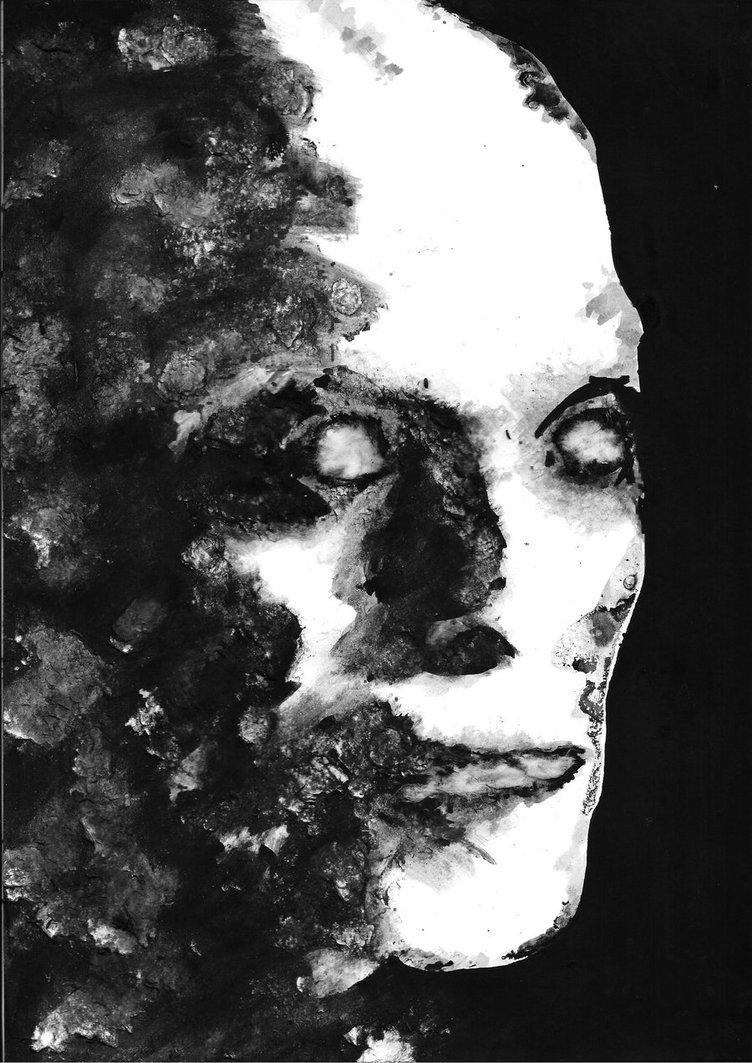Details
- 2012-10-11
- 0
- 91
- 2012
- Painting
- Ink
- Religion
Pricing
Price and availability not indicated

- DEATH IS JUST THE BEGINNING -
Description by Mister 13
Ink, brush, kleenex and cotton, 2 coffee, one cigarette. I fixed some cotton in the eyes and the mouth, and it gives a really creepy texture. A death mask is a wax or plaster cast made of a person’s face following death. Death masks may be mementos of the dead, or be used for creation of portraits. It is sometimes possible to identify portraits that have been painted from death masks, because of the characteristic slight distortions of the features caused by the weight of the plaster during the making of the mold. In other cultures a death mask may be a clay or another artifact placed on the face of the deceased before burial rites. The best known of these are the masks used by ancient Egyptians as part of the mummification process, such as Tutankhamun’s burial mask. In the seventeenth century in some European countries, it was common for death masks to be used as part of the effigy of the deceased, displayed at state funerals. During the eighteenth and nineteenth centuries they were also used to permanently record the features of unknown corpses for purposes of identification. This function was later replaced by photography. Masks of deceased persons are part of traditions in many countries. The most important process of the funeral ceremony in ancient Egypt was the mummification of the body, which, after prayers and consecration, was put into a sarcophagus enameled and decorated with gold and gems. A special element of the rite was a sculpted mask, put on the face of the deceased. This mask was believed to strengthen the spirit of the mummy and guard the soul from evil spirits on its way to the afterworld. The best known mask is that of Tutankhamun. Made of gold and gems, the mask conveys the highly stylized features of the ancient ruler. Such masks were not, however, made from casts of the features; rather, the mummification process itself preserved the features of the deceased. In 1876 the archaeologist Heinrich Schliemann discovered in Mycenae six graves, which he was confident belonged to kings and ancient Greek heroes—Agamemnon, Cassandra, Evrimdon and their associates. To his surprise, the skulls were covered with gold masks. It is now thought by some unlikely that the masks actually belonged to Agamemnon and other heroes of the Homeric epics. The lifelike character of Roman portrait sculptures has been attributed to the earlier Roman use of wax to preserve the features of deceased family members. The wax masks were subsequently reproduced in more durable stone. In the late Middle Ages, a shift took place from sculpted masks to true death masks, made of wax or plaster. These masks were not interred with the deceased. Instead, they were used in funeral ceremonies and were later kept in libraries, museums and universities. Death masks were taken not only of deceased royalty and nobility (Henry VIII, Sforza), but also of eminent persons—poets, philosophers, composer, and dramaturges, such as John Keats, Frederic Chopin, Franz Liszt, Ludwig van Beethoven, Joseph Haydn, Dante Alighieri, Filippo Brunelleschi, Torquato Tasso, Blaise Pascal and Voltaire. As in ancient Rome, death masks were often subsequently used in making marble sculpture portraits, busts or engravings of the deceased. Death masks were increasingly used by scientists from the late eighteenth century onwards to record variations in human physiognomy. The life mask was also increasingly common at this time, taken from living persons. Anthropologists used such masks to study physiognomic features in famous persons and notorious criminals. Masks were also used to collect data on racial differences. Before the widespread availability of photography, the facial features of unidentified bodies were sometimes preserved by creating death masks so that relatives of the deceased could recognize them if they were seeking a missing person. One mask, known as L'Inconnue de la Seine, recorded the face of an unidentified young woman who, around the age of sixteen, according to one man's story, had been found drowned in the Seine River at Paris, France around the late 1880s. A male pastologist at the Paris Morgue was so taken by her beauty that he worked for hours to make a plaster cast of her face. She was considered so beautiful that the worker said, "Her beauty was breathtaking, and showed few signs of distress at the time of passing. So bewitching that I knew beauty as such must be preserved." The cast was also compared to Mona Lisa, and other famous paintings and sculptures. In the following years, copies of the mask became a fashionable fixture in Parisian Bohemian society. When taken from a living subject, such a cast is called a life mask. Proponents of phrenology and ethnography used both death masks and life masks for pseudoscientific purposes.







